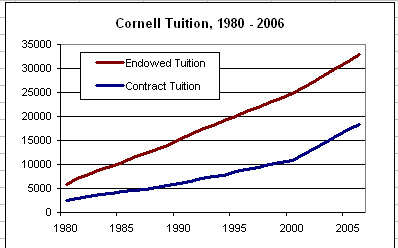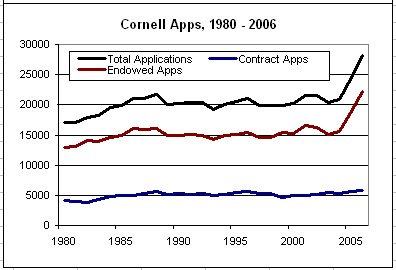On Tuesday, the New York Times ran an article suggesting that a college can become more popular (ergo, more selective, ergo, ranked higher) simply by increasing tuition. Harvard economist Greg Mankiw offers some thoughts on the idea here. The idea might hold some water for less prestigious private institutions that recruit students from the upper middle-class; every self-respecting members of the bourgeoisie wants to give their child the best education that money can buy. So maybe for Ursinus College yes, but I doubt that the same holds for a well-established and popular institution like Notre Dame, Swarthmore, or even Cornell. Once a college has a dedicated potential applicant pool, simply increasing tuition will not improve the popularity of a college, all other things equal. Simple antecdotal evidence from data provided by Cornell's Institutional Research and Planning office proves this point. Over the last five years, in-state tuition to attend one of the three undergraduate contract colleges has increased rapidly relative to the tuition of the endowed colleges (notice the "kink" in the blue line around 2001 in the first graph) . But that hasn't improved the contract colleges' popularity at all (note the blue line in the second graph) -- indeed the only significant change in the number of applications Cornell has received over the last 20 years came two years ago when Cornell adopted the common application, and of those additional applicants who bothered to explicitly state which college they wanted to apply to, the vast majority of them applied to Cornell's endowed colleges. Tuition aside, I think there is a lot Cornell can do to increase the visibility and attractiveness of its contract colleges, and if Cornell has any "image problem", it is the idea that these colleges are somehow substantially different from the rest of Cornell. That these colleges haven't increased the number of applications they have received over the last 20 years is a concern, especially given that these colleges offer programs in some of the most popular and growing areas of higher education -- business, applied economics, bio-engineering, statistics, and public policy. 

 | ||

